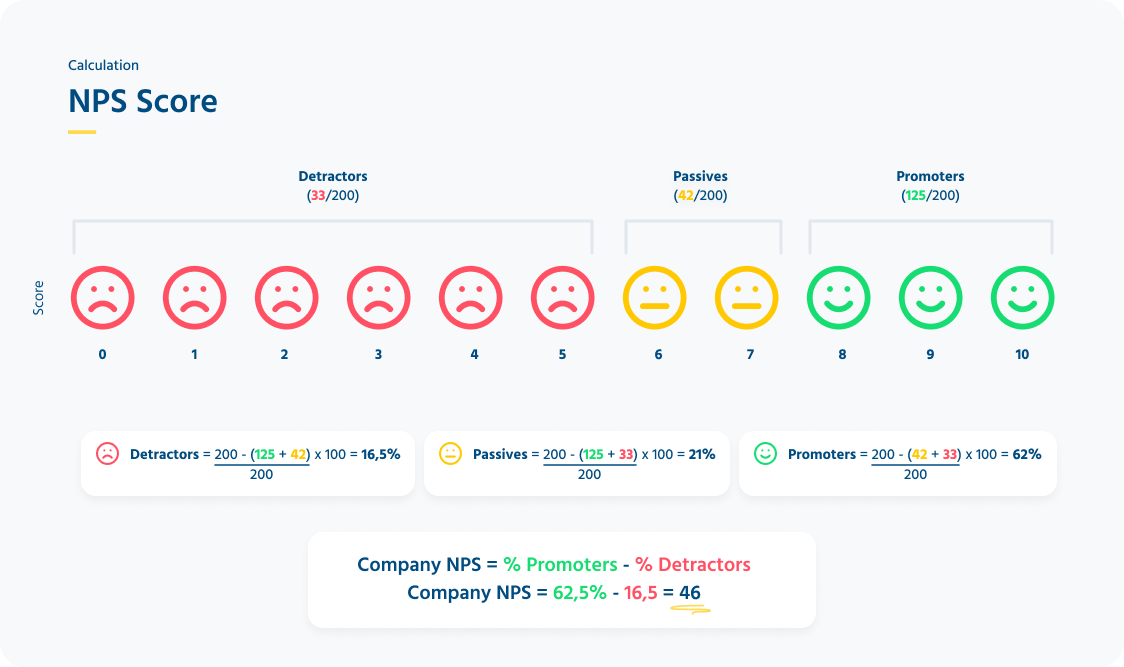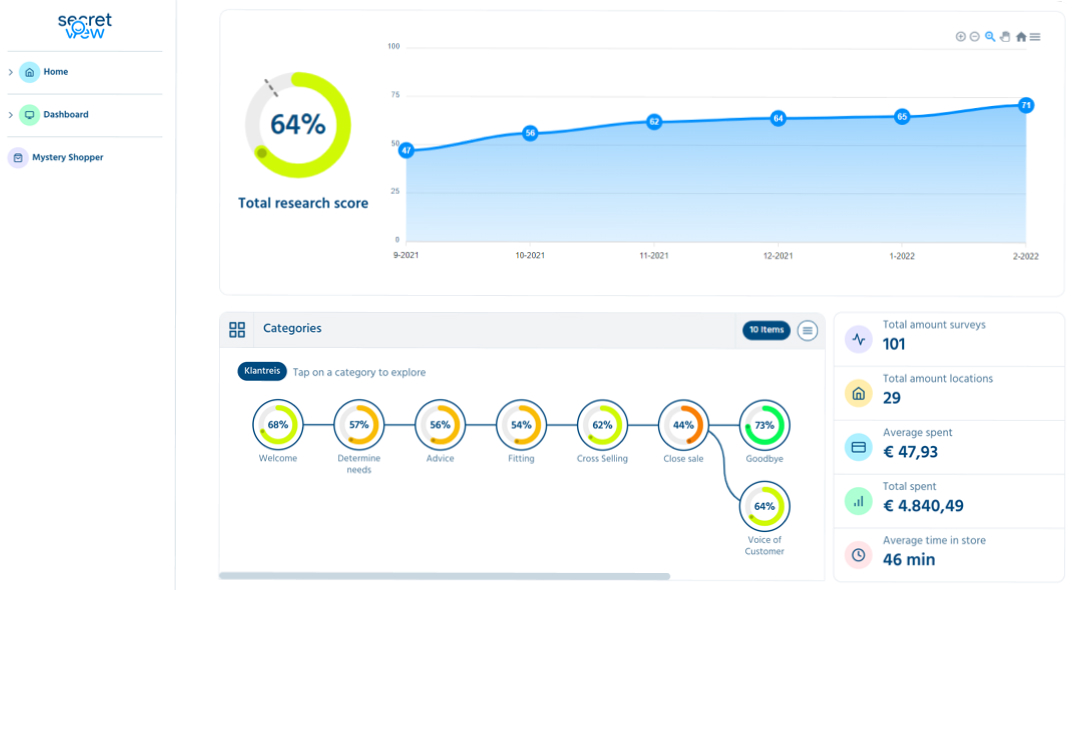5 types of customer experience research
In the world of retail, there are so many questions to answer. Nowadays, (almost) everything is measurable, including customer experience. However, measuring experiences remains a challenge. There are many different research methods, each with their own advantages and disadvantages. With all these types of research and different KPIs, it can be difficult to keep track of what’s suitable for you. That's why we have listed the most important types of customer experience research, including their purpose and when to apply them.

Net Promoter Score® (NPS)
What is NPS?
NPS stands for Net Promoter Score® and is based on a simple question with a ten-point scale: On a scale of 0 to 10, how likely is it that you would recommend company/organization X to family, friends, or colleagues?
It’s a quick way to measure customer satisfaction and provides insight into the overall image a customer has of a brand. Because it’s such a simple question, NPS is widely used. It's perhaps the most well-known research method, and both loved and hated.
NPS can go wrong when the means becomes an end in itself. It'sa quantitative research method and does not provide tools for improvement. NPS is the thermometer with which you find out how satisfied customers are. But if you want to know why things are going well or badly, you need additional qualitative research. You don't know why your respondents give a certain score, so you need additional research to find out the ‘why’ behind their answers.
How is NPS calculated?
People who give a score between 0 and 6 are in Detractors group. People who give a 6 or 7 are Passives. People who give an 8, 9 or 10 are Promoters.

How do you deal with the results from NPS?
When do you jump for joy with NPS? This varies by industry, but there are general NPS principles. In essence, any outcome above 0 is good, as this means you have more promoters than detractors. Most companies are only happy above 50 and extremely happy above 70.
When do you apply NPS?
NPS research is suitable for any company or service that has customers, whether It'sa store, a technology company, a financial service, or a health care provider. It'sa universal way to measure customer satisfaction and the likelihood of them recommending you to others. However, you need volume. NPS has little value with a low response rate. So whether you run a webshop or a hotel, NPS research is a great way to know if your customers are happy (or not so happy), despite the downsides.
Mystery shopping research
What is mystery shopping research?
In mystery shopping research, a person who is unknown to the company poses as a regular customer to evaluate the company or service. This may include aspects such as customer service, compliance, or the overall shopping experience in a store.
For example, the shopping experience is a top priority for a cosmetics retail chain. The appearance of the store and its employees, the advice given, the greeting, and the entire customer journey in the store are all planned out. This chain operates worldwide and the customer experience should be the same in every store.
Mystery shoppers visit each store weekly. This provides insight to every level of the organization on how stores, countries, and regions are performing. The data is presented in a dashboard, making it easy to make adjustments at every level. A store manager advises an employee, a regional manager helps a store, and a country manager helps a region.

When do you apply mystery shopping?
Suppose that NPS or one of the following research methods indicates that the scores of a particular store are lagging behind. You don't know what's going wrong, only that something is not right. With mystery shoppers, you can precisely determine where the pain points are in the customer journey. This also gives employees clues for improvements. You then use training on these points and subsequently monitor the results with ongoing research.
Mystery shopping research is therefore a valuable addition to other research methods. It allows you to measure much more and in more detail than with other customer experience research methods. Research can be fully customized.
How do you deal with the results of mystery shopping research?
Mystery shoppers can be used for a broad range of goals. The reasons for retail organizations to choose mystery shopping research vary, and so is the application of the results.
These are some of the most common reasons:
- Concrete examples during evaluation meetings: Mystery guests are real customers who share their experience. This also provides real input for evaluation meetings with employees.
- Awareness of behavior: With ongoing mystery shopping research, you keep employees sharp and aware of their behavior.
- Measuring progress: Goals are set by higher management. With mystery shopping research, you measure whether there is progress.
- More effective training: Instead of shooting in the dark, you now know the weaknesses per location. This makes training much more effective!
CES (Customer Effort Score research)
What is CES research?
Customer Effort Score (CES) research is a way to measure how much effort customers have to make to solve a problem or answer a question. It indicates how easy or difficult it was for a customer to get help or find a solution. It'san important way to measure how satisfied customers are with the service they received and to see where improvements are needed.
Usually, a single question is asked, such as "On a scale of 1 to 5, how much effort did you have to put in to solve your problem?" This way, you can calculate an average score and evaluate the satisfaction of customers.
When do you apply CES research?
CES research is suitable for almost every situation in which a company interacts with customers, such as customer service, sales, or technical support. It'shandy if you want to know how easy it was for customers to get help or solve their problems. This can help identify problems and point out areas for improvement.
For example, if you get a high CES score, it means that customers could easily get help and solve their problems quickly. On the other hand, a low CES score may indicate that customers had difficulty finding help or that the process of solving their problems took too long.

How do you deal with the results of CES research?
The results of a CES research can be interpreted by calculating the average score and comparing it with a reference point or an internal benchmark. A score of 5 on a scale of 1 to 5 suggests that customers had little trouble solving their problems, while a score of 1 suggests that customers had a lot of trouble.
It's also important to look at individual answers to see if there are specific problems or bottlenecks that require attention. You can also look at the results of different customer groups, such as new customers or returning customers, to see if there are differences in how easy it was for them to get help.
Another way to interpret the results is by looking at the change in CES over time. If the score is increasing, this means that customers are having an easier time resolving their issues, suggesting that improvements in customer service or processes are effective. If the score is decreasing, it suggests that there are issues that need to be addressed quickly.
It's important to remember that the CES score is only an indication of customer satisfaction and that it's not the only metric you should use to evaluate customer satisfaction. Combine it with other metrics such as NPS or customer satisfaction surveys for a more complete picture.
CSAT (Customer Satisfaction Score)
What is a CSAT survey?
With CSAT, you measure customer satisfaction after they have made a purchase from a company or received a service. CSAT predicts customer loyalty and uncovers weaknesses in the customer experience.
CSAT revolves around a simple question: "How satisfied are you with your recent experience with or purchase from company X?" Like NPS, this is a quick survey to answer, increasing effectiveness. Most CSAT surveys work with a five-point scale, usually displayed with stars or smileys.

When do you apply a CSAT survey?
There are several moments when you apply a CSAT survey, some examples are:
- After the sale: When a customer has purchased a product or service, it's important to know if they are satisfied with their purchase. This can be determined by sending a survey or questionnaire after the sale, allowing you to quickly address any issues or dissatisfaction.
- After the delivery of a service: When providing a service, such as a repair, it's important to know if the customer is satisfied with the service provided. This can be determined by sending a survey or questionnaire after the service delivery.
- Regularly: It's also important to conduct CSAT surveys regularly, even if there is no specific event. This allows a company to get a sense of overall customer satisfaction and quickly identify and address any problems.
- After a complaint: Another important application of CSAT surveys is after a complaint. This allows you to quickly determine if the customer is satisfied with the solution.
How do you deal with the results from a CSAT survey?
Like NPS, CSAT doesn’t tell you why people give a certain score. To find out, follow-up questions are often added, such as 'Explain why you gave this score.' It does provide a good picture of the overall sentiment among your customers and how you're doing compared to competitors.
If you score mainly four and five, then your customers are very satisfied. If you mainly score one to three, then you're not meeting customers' expectations and they probably won't return. By analyzing the results from CSAT, you can see which customers need attention. You can then adapt your product or service accordingly.
Online reviews such as Trustpilot, Google, and Facebook

Lastly there are online reviews on sites such as Trustpilot, Facebook, or Google Reviews. Here, people can give their opinion about your company unfiltered and publicly. Often on a five-point scale with stars and the ability to give a brief explanation of the score. As the business owner, you can then respond to reviews.
It's very easy and simple to leave an online review. That's both an advantage and a disadvantage. It encourages extreme response bias. It's highly satisfied or highly dissatisfied customers who often take the step to leave an online review. Someone who is moderately satisfied will be less likely to write a review.
Positive reviews:
- Always thank people for their positive feedback. This shows that you appreciate their opinion and are interested in their experiences.
- Share these positive reviews on your website and social media. This helps to build a positive reputation and can attract new customers.
Negative reviews:
- Stay calm and polite when responding to a bad review. This shows that you are interested in resolving issues and value your customers.
- Try to solve the problem by contacting the customer directly and asking how you can better assist them. This can lead to a positive solution for the customer and may even result in a positive review.
Remember that a few bad reviews are not the end of the world, as some people will always be dissatisfied. The key is to find a balance between gathering positive reviews and addressing negative reviews. This will keep your reputation in check and make your appealing to potential customers.
Want to start measuring customer satisfaction?
You now have an overview of the most commonly used research methods for customer satisfaction. Most studies only provide quantitative data. This tells you that something is happening, but in order to understand what It'sand why it's happening, you need to conduct more in-depth research. Qualitative research such as mystery shopping provides the "why".
Would you like to discuss further which research method is best for you? We are happy to help you find the right solution and show you the possibilities of our tool.




